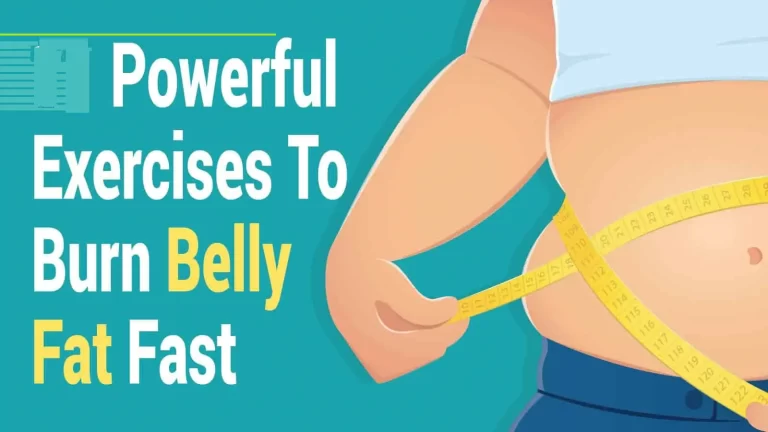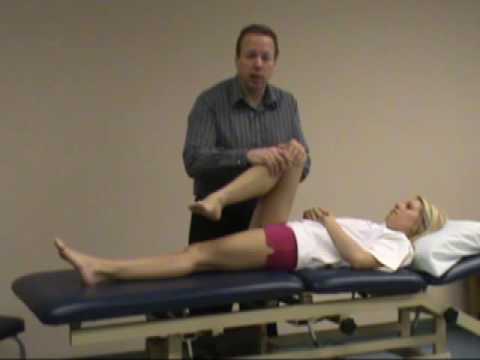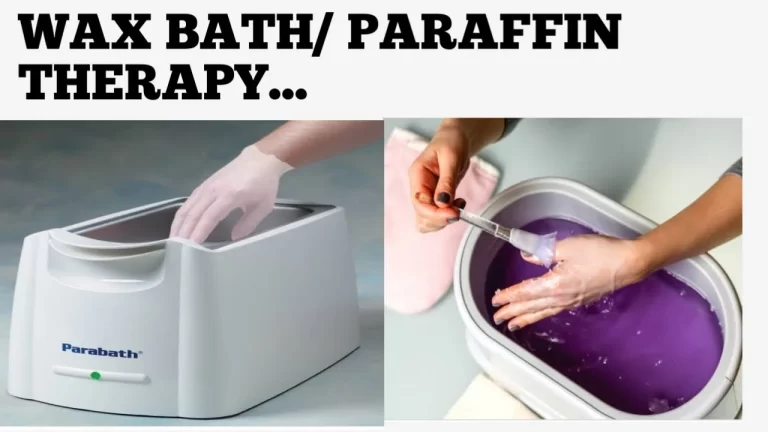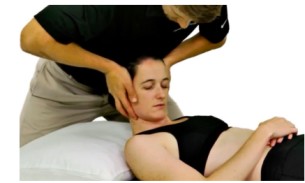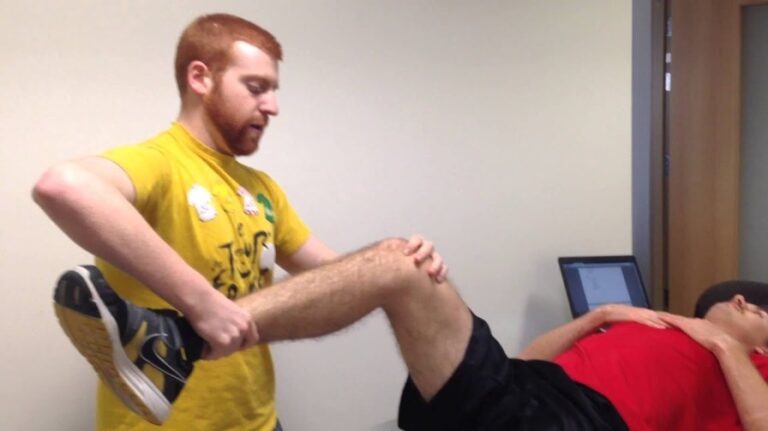Muscle Energy Technique (MET)
Description
Muscle Energy Technique (MET) is a technique that was invented in 1948 by Fred Mitchell, Sr, D.O. It is a type of manual therapy, widely used in Osteopathy, that uses a muscle’s energy in the form of gentle isometric contractions to relax the muscles via autogenic or reciprocal inhibition and lengthen the muscle.
As compared to static stretching which is a passive approach in which the therapist does all the work, the Muscle energy technique is an active technique in which the patient is also an active participant. MET is based on the visions of Autogenic Inhibition and Reciprocal Inhibition. If a sub-maximal contraction of the muscle is observed by stretching of the same muscle it is known as Autogenic Inhibition MET, and if a submaximal contraction of a muscle is obeyed by stretching of the opposing muscle then this is known as Reciprocal Inhibition MET.
What is Muscle Energy Technique (MET)?
Muscle energy techniques (METs) are a state of osteopathic manipulative diagnosis and treatment in which the patient’s muscles are actively used on request, from a precisely restrained position, in a distinctive direction, and against a distinctly managed counterforce. MET is a type of manual therapy technique used to lengthen, strengthen and enhance the range of movement of muscles.
Your physiotherapist will resist the desired muscle while you contract it and push to oppose the physiotherapist. This contraction is held for about 5 seconds and the process is recounted several times with a quick rest in between. METs are exceptional in their application in that the client provides the initial effort and the practitioner just relieves the process.
The primary force comes from the contraction of the client’s soft tissues (muscles), which is then utilized to help correct the presenting musculoskeletal dysfunction. The muscle energy technique is characterized by a patient-induced skeletal muscle compaction against an operator’s resistance in a controlled direction and position. More especially, isometric MET entails the following steps:
- Sequestration of the target joint and/or muscle barrier through joint positioning, normally to a pathologic barrier.
- This is obeyed by active muscle contraction by the patient in a specific direction, typically away from the restriction, for a specified period against provider-applied counterforce. Conventionally, the amount of force induced by the patient should be the maximum amount comfortably tolerated by both the patient and practitioner.
- A respite of the contracted muscle.
- Passive movement of the patient’s anatomy toward an unexplored pathologic border
- Repeat steps 1 to 4 as tolerated until physiologic pain is adequately relieved and/or the achievement of the desired range of motion.
Within this framework, various protocols have been developed with varied specifics for each step, including duration and strength of contraction, duration of rest, and the number of repetitions. For instance, the Greenman method proposes a five-to-seven-second relaxation step and three-to-five repetitions overall. The goal of this therapy is to generate relaxation of a muscle or muscle group, the hypertonicity of which is proposed to be the source of pain and/or loss of mobility in a body part and/or joint. The primary theories behind this phenomenon entail post-isometric relaxation – the reduction in tone of an agonist’s muscle following isometric contraction, and reciprocal inhibition – the reduction in tone of an antagonist’s muscle after its agonist has undergone isometric compaction. Both of these spectacles are well understood on a cellular level.
Muscle Energy Technique protocols developed differ in paradigms, such as in the digit of repetitions, the strength of contraction, duration of the stretch phase, and duration of the relaxation phase. Two of the most prominent Muscle Energy Technique typologies of application are those advocated by Greenman and Chaitow.
The first concerns the application of three to five repetitions with a relaxation phase long enough to decrease the tension of the targeted issue (usually 5 to 7 s), whereas the second involves the application of four repetitions with a relaxation or stretch phase of 30 to 60 s after each contraction. Other authors have also used similar MET applications, although a consensus on which protocol could be more effective still needs to be investigated. Aside from the structure of the application, the main physiological mechanism suggested for the muscle energy technique involves two general principles:
- post-isometric relaxation, which induces a deduction in the tone of a muscle following an isometric contraction and
- reciprocal inhibition, which involves the reduction in the tone of the antagonist’s muscle following the isometric contraction of the agonist’s muscle through inhibition of the alpha motor neuron.
Post-isometric relaxation is the most repeatedly applied approach, while reciprocal inhibition is used when tissue has severe restrictions or has become fibrotic, as a treatment modality associated with post-isometric relaxation. Although many texts support these as the principal mechanisms accountable for muscle relaxation, it has been seen in studies analyzing joint extensibility that including an isometric contraction, does not alter resting EMG activity, notwithstanding increased ROM. In expansion, another study evaluating motor neuron activity has shown increases in EMG activity also obeying concentric and eccentric contractions. A greater expansion was seen in the first case while such an increase was less pronounced in the latter.
The exact mechanism for MET-induced pain relief is still unknown, although it has been proposed that the muscle energy technique act on joint proprioceptors and mechanoreceptors that will result in an influence on descending pathways, changing the motor programming of the marked joint. It has also been suggested that the reduction of pain and increased mobility are due to changes in the viscoelastic properties of the soft tissue followed by the application of the technique; the mechanism for improved flexibility has been attributed to an increase in stretch tolerance. Very few studies investigating the effects of the different typologies and efficacies of MET have been performed; therefore, this review aims to understand the efficacy of muscle energy technique specifically on pain and joint range of motion, and to understand the distinctions between the different Muscle Energy Techniques protocols in symptomatic and asymptomatic subjects.
What is Autogenic and Reciprocal Inhibition?
Autogenic and reciprocal inhibition both happen when particular muscles are inhibited from contracting due to the activation of the Golgi tendon organ (GTO) and the muscle spindles. These two musculotendinous proprioceptors located in and about the joints and muscles respond to modifications in muscle tension and length, which assists manage muscular control and coordination. The Golgi tendon organ, located between the muscle belly and its tendon, senses raised tension when the muscle contracts or stretches. When the muscle contracts, the GTO is activated and reacts by inhibiting this contraction (reflex inhibition) and contracting the opposing (antagonist) muscle mass. This process is comprehended as autogenic inhibition.
The GTO response recreates an important role in flexibility. When the Golgi tendon organ inhibits the (agonist) muscle’s contraction and permits the antagonist muscle to contract more readily, the muscle can be stretched further and easier. Autogenic inhibition is frequently seen during static stretchings, such as during a low-force, long-duration stretch. After 7 to 10 seconds, muscle tension enlargements and activates the Golgi tendon organ response, causing the muscle spindle in the stretched muscle to be inhibited temporarily, which makes it attainable to stretch the muscle further.
The muscle spindle is encountered within the muscle belly and stretches ahead with the muscle itself. When this occurs, the muscle spindle is activated and generates a reflexive contraction in the agonist’s muscle (known as the stretch reflex) and relaxation in the antagonist’s muscle. This procedure is known as reciprocal inhibition.
Pathophysiology of MET
The increased muscle tone purportedly treated by the muscle energy technique is comparable to that of the hypertonicity and/or spasticity that presents in upper motor neuron disease. The raised activity of the extrafusal muscle fibers may also be secondary to either increased activity of the muscle spindle or abnormal sensory processing in the spinal cord. In the former, improved activity of γ-motor neurons directs to abnormally shortened muscle spindles, thus leading to a hyperexcitable state such that movement within the physiologic range of motion delivers reflexive muscular contraction. Likewise, type II fibers have been hypothesized to contribute to spasticity through direct α-motor neuron activation.
Mechanism of action for Muscle Energy Technique
Muscle energy is a direct and active technique; suggesting it employs a restrictive barrier and requires the patient’s participation for maximal effect. A restrictive barrier represents the limit in the range of motion that prevents the patient from being able to reach the baseline limit in his range of motion. As the patient completes an isometric contraction, the ensuing physiologic changes occur:
- Golgi tendon organ activation effects in direct inhibition of the agonist’s muscles
- A reflexive reciprocal inhibition arises at the antagonistic muscles
- As the patient relaxes, agonist and antagonist muscles stay inhibited allowing the joint to be moved further into the restricted range of motion.
Despite the many assertions made regarding the efficacy of these techniques, there are only two peer-reviewed studies that have shown that muscle energy techniques can also significantly reduce disability and enhance functionality in patients with disorders such as low back pain
Types of Muscle Energy Technique (MET):
Autogenic Inhibition MET
- Post Isometric Relaxation (PIR)
- Post Facilitation Stretching (PFS)
Reciprocal Inhibition MET
Autogenic Inhibition MET
As already noted Autogenic Inhibition METs work on the principle of autogenic inhibition. The two major and well-known types of MET that are based on the idea of autogenic inhibition are Post Isometric Relaxation (PIR) and Post facilitation Stretching (PFS).
Post Isometric Relaxation (PIR) – Post Isometric Relaxation is a technique that was later evolved by Karel Lewitt. Post Isometric Relaxation (PIR) is the effect of the decrease in muscle tone in a single or group of muscles, after a temporary period of submaximal isometric contraction of the same muscle. PIR works on the idea of autogenic inhibition.
The PIR technique is performed as follows:
The hypertonic muscle is taken to a measurement just short of pain, or to the point where resistance to movement is first noted.
- A submaximal (10 to 20%) contraction of the hypertonic muscle is performed away from the barrier for between 5 and 10 seconds and the therapist applies resistance in the opposite direction. The patient should inhale during this action.
- After the isometric compaction, the patient is asked to relax and exhale while doing so. Following this, a gentle stretch is applied to take up the slack till the new barrier is.
- Starting from this new barrier, the process is repeated two or three times.
- Golgi tendon organs (GTOs) are mechanoreceptors located in most skeletal muscles.
They are sensitive to muscular contractile force, and in contrast to muscle spindles (see below), Golgi tendon organs are infrequently and inconsistently executed by muscle stretch. These encapsulated heaps of collagen are innervated by fast-conducting type Ib afferent fibers, and are present at muscle-tendon or muscle-aponeurosis junctions; they connect to a specific muscle fascicle tendon on one end, and the entire muscle-tendon or aponeurosis of the other. This positioning, often described as “in-series,” meaning the receptor is part of the functional unit, stands in distinction to the muscle spindle that works contiguous to the functional unit, “in resemblance.” Golgi tendon organs are activated at high levels of force and hypothetically inhibit muscle activity, precluding musculoskeletal injury.
Physiologically, improved tension to the Golgi tendon organs prompts the activation of the type Ib afferent fibers that project to the spine, where they nourish positive input on inhibitory interneurons that, in turn, add negative or “inhibitory” input on the efferent α-motor neurons that acquire input from the cortex to the homonymous muscle. In consequence, sufficient Golgi tendon organ stimulation can override the muscle-activating signal from the brain, conducting relaxation. This phenomenon is called the “inverse stretch” or the “autogenic” reflex.
Post Facilitation Stretch (PFS) –
Post Facilitation Stretch (PFS) is a technique designed by Janda. This technique is more emphasized than PIR but is also based on the concept of autogenic inhibition.
The PFS technique is performed as follows:
- The hypertonic and shortened muscle is placed between a fully stretched and a fully flexible state.
- The patient is asked to tighten the agonist using maximum effort for 5 to 10 seconds while the therapist resists the patient’s force.
- The patient is then asked to relax and release the effort, whereas the therapist involves a rapid stretch to a new barrier and is held for 10 seconds.
- The patient comforts for approximately 20 seconds and the process is repeated between three to five times and five times more.
- Rather than starting from a new barrier, the muscle is placed between a fully stretched and a fully relaxed state before every repetition.
Reciprocal Inhibition MET
Reciprocal Inhibition MET is different from the overhead two techniques in that it involves the contraction of one muscle obeyed by stretching of the opposite muscle, because opposite to PIR and PFS, Reciprocal Inhibition MET as the name implies is established on the concept of Reciprocal Inhibition.
The Reciprocal Inhibition MET procedure is performed as pursues:
- The manufactured muscle is placed in a mid-range position.
- The patient pushes towards the restriction or barrier whereas the therapist completely opposes this effort (isometric) or allows a movement towards it (isotonic).
- This is followed by relaxation of the patient along with exhalation, and the therapist involves a passive stretch to the new barrier.
- The approach is repeated between three to five times and five times more.
Muscle spindles are stretch-sensitive mechanoreceptors located in skeletal muscle. A muscle spindle is a fortune of striated, “intrafusal” muscle fibers within the fascicles of force-producing, “extrafusal” muscle fibers. “Fusal,” arrives from the term “fusiform,” meaning spindle-shaped. Any stretch, or change in length, of the extrafusal fibers, thus results in a stretch of the intrafusal fibers, which is then detected in the equatorial and polar regions of the muscle spindle. This physiology stands in contrast to GTOs which are relatively insensate to passive changes in length but respond to an increase in muscle force. The stretch sensation is estimated by two types of afferents: primary (type Ia) and secondary (type II).
There is a single Ia fiber and anywhere between zero-to-five II fibers per spindle. The Ia fiber is equal in size and pace of transmission to the previously noted Ib fibers and supplies all intrafusal fibers in the spindle at the equatorial region. The identical function of type II fibers is less understood; yet, these smaller fibers terminate on the polar ends of the spindle. Muscle spindles are outstanding among proprioceptors in that efferent fibers innervate them. These myelinated γ-motor neurons derive from the exact efferents that supply the extrafusal muscle. Excitation of these γ-motor neurons does not affect overall muscle tension but occurs to maintain tension on the muscle spindles to track the length of the extrafusal fibers effectively. Lastly, spindle afferents are tonically active, with an improved firing rate in response to passive stretch in a velocity-dependent manner. For more additional, see the Monosynaptic Reflex article.
Physiologically, stretch to a muscle fiber produces activation of Ia muscle spindle afferents that project to the spine and trigger the efferent α-motor neurons, and henceforward, the γ-motor neurons of the homonymous muscle causing to contraction of the intra- and extrafusal fibers. Simultaneously, the Ia fibers trigger inhibitory interneurons in the spine to inhibit the α-motor neurons of the antagonist’s muscle. This trajectory is simply described as the “stretch reflex.” This pathway is thought to prevent the over-lengthening of a muscle and to be instrumental in activities such as bipedal walking and posture
Techniques of MET
Muscle energy techniques can also be applied to most areas of the body. According to one book, each technique requires 8 essential steps:
- Perform and obtain an accurate structural diagnosis.
- Encounter the restrictive barrier in as many planes as possible.
- Physician and patient contend in an unyielding counterforce where the patient’s force matches the physician’s force.
- The patient’s isometric compaction has the correct amount of force, the correct direction of effort (out from the restrictive barrier), and the correct duration (5 to 10 seconds).
- Complete relaxation occurs after the muscular effort.
- The patient is repositioned into the new restrictive border in as many planes as possible.
- Steps 3 to 6 are repeated around 3 to 5 times or until no further improvement in range of motion is observed.
- The structural diagnosis is repeated to evaluate if the dysfunction has resolved or enhanced.
Evidence of Muscle Energy Techniques in Physiotherapy
Franke et al in a systematic review investigated the effectiveness of MET in the treatment of patients with non-specific low back pain (LBP) in comparison with management interventions. It was found that there is a poor grade of randomized control trial (RCT) studies of MET treatment in patient populations with non-specific LBP. This suggests that better quality investigations are needed to confirm the effectiveness of MET for non-specific LBP. In a randomized management trial performed by Szulc et al, the efficacy of a combined method of Mckenzie and muscle energy technique was analyzed for patients with low back pain.
The analysis showed positive results of a combination of Mckenzie and MET treatments in terms of significantly decreased outcomes in the Oswestry Disability Index, significant alleviation of pain in the Visual Analogue Scale (VAS), and significantly decreased the size of spinal disc herniation. The combined method can be effectively used in the therapy of chronic LBP. Phadke et al in an RCT examined the effect of MET and static stretching on pain and functional disability in patients with mechanical neck pain. It was found that the muscle energy technique was better than the static stretching procedure in terms of outcomes in VAS and the Neck Disability Index (NDI). An immediate effect of MET on Posterior Shoulder Tightness was found in basketball participants in an RCT performed by Moore et al. There were advancements in the glenohumeral joint range of motion in horizontal adduction and internal rotation.
Examples of Muscle Energy Techniques
Therapist Administered MET
Psoas Major
- Starting Position – Thomas test position: Supine on the plinth, target leg hanging off the plinth, the other leg in 90 degrees flexion the rest of the body on the plinth
- Therapist’s hand 1 – Just above the knee of the plinth
- Therapist’s hand 2 – Just above the knee of the leg in flexion
- Patient action – Flexes the hip hanging off the plinth
ITB
- Starting Position – Side-lying, target leg off the plinth
- Therapist’s hand 1 – Over superior lateral thigh
- Therapist’s hand 2 – Over superior lower leg
- Patient action – Abducts the hip
Hip External Rotators
- Starting Position – Crook-lying
- Therapist’s hand 1 – Over lateral mid-thigh
- Therapist’s hand 2 – Over inferior mid-thigh
- Patient action – Abducts leg against the therapist
Self-Administered MET
Hip Flexion/Hip Extension
- Patient in crook lying positions foot on the contralateral knee – Fetches foot down against knee, conveys a knee up against the foot
Hip adduction
- The patient has a ball between their legs in a crook lying, presses the ball
Hip external rotation
- The patient is in a prone with the hip and knee flexed to 90 degrees, The therapist drives the knee into internal rotation, and the patient pushes against the therapist
Scalenes
- Patient in supine, shoulders on a pillow, head pivoting off pilow
- The therapist positions into extension and rotation
- The patient fights the therapist into neutral (flexing and rotating)
Clinical Significance
As mentioned in the preface, MET primarily serves to improve the range of motion and decrease pain. These procedures are used by physicians, both osteopathic and allopathic, as well as physical therapists and chiropractors as primary or as adjunctive therapy. In the case of the former, the muscle energy technique is generally employed to reduce pain secondary to hypertonicity in the back, neck, and other major joints, but may hypothetically be utilized to directly treat nearly any joint in the body. As for the latest, MET, in addition to standard-of-care treatment, as well as other osteopathic techniques, has been demonstrated to enhance outcomes in conditions such as pneumonia and fibromyalgia. In these cases, the complementary effects are attributed to fascial stretching, which is proposed to improve the lymphatic and hemodynamic process.
A handful of metanalyses have been performed to assess the effectiveness of MET in the therapy of various conditions, particularly of low back pain. While some yielded mixed results, there is an apparent concurrence on the positive effects of muscle energy technique on low back pain, with insufficient and inconsistent proof to support its use in other circumstances.
How does MET help?
MET is based on reciprocal inhibition which is the approach that when a muscle is contracting, the opposite muscle of the joint is relaxing. So as one muscle is tightening against your physiotherapist, the opposite muscle is being stretched. muscle energy technique allows the person to contract and stretch the muscle to its full potential and take the joint to its full range of movement. When this is repeated, gains may also be made in muscle flexibility and strength.
Indication of MET?
Muscle Energy Techniques can also be used for any condition in which the goal is to cause relaxation and lengthening of the muscles and improve the range of motion (ROM) in joints. Muscle energy techniques may also be applied safely to virtually any joint in the body. Many athletes use MET as a preventive measure to guard against future injury of muscles and joints. It is mainly used by people who have a limited ROM due to facet joint dysfunction in the neck and back, and for more comprehensive areas such as shoulder pain, scoliosis, sciatica, asymmetrical legs, hips, or arms, or to treat chronic muscle aches, stiffness or injury
MET can be utilized by healthy persons to maintain muscle flexibility and prevent injury. MET is also used as a treatment for problems such as:
- Pain inhibited the movement of the neck, shoulders, and back
- Sciatica
- Scoliosis pain
- Contractures
- Leg length discrepancy
- Muscle injury
- Muscle tightness
What are the benefits of MET?
When introducing the concept of METs, one of the benefits I emphasize is their help in normalizing joint range, rather than in improving flexibility. This might sound counterintuitive; what I am saying is if, for instance, your customer cannot rotate their neck (cervical spine) to the right as far as they can to the left, they have a limitation of the cervical spine in a right rotation. The normal rotational range of the cervical spine is 80 degrees, but let’s say the client may only rotate 70 degrees to the right. This is where METs come in.
After a MET has been employed on the tight restrictive muscles, hopefully, the cervical spine will then be capable of rotating to 80 degrees, the patient has made all the effort and you, the practitioner, have promoted the cervical spine into further right rotation. You have now enhanced the joint range to “normal.” This is not pushing in the most rigorous sense, even though the prevailing flexibility has been improved, it is only to the point of achieving what is considered to be a normal joint range.
Depending on the context and the type of MET operated, the objectives of this treatment can contain:
- Restoring normal tone in hypertonic muscles
- Strengthening weak muscles
- Preparing muscles for subsequent stretching
- Increasing joint mobility
Restoring Normal Tone in Hypertonic Muscles
- Through the simple process of METs, we as manual therapists try to achieve relaxation in the hypertonic shortened muscles.
- If we think of a joint as being limited in its range of motion, then through the initial identification of the hypertonic structures, we can employ the techniques to assist achieve normality in the tissues.
- Certain types of massage therapy can also help us achieve this relaxation effect, and generally, MET is applied in conjunction with massage therapy.
- I feel that massage with motion is one of the best tools a therapist has.
Strengthening Weak Muscles
- METs can be used in the strengthening of weak or even flaccid muscles, as the clients are asked to contract the muscles before the lengthening process.
- The therapist should be able to modify the MET by asking the client to contract the muscle that has been classified as weak, against a resistance applied by the therapist (isometric contraction), the timing of which may differ.
- For example, the patient can be asked to resist the movement using approximately 20 to 30% of their maximum capability for 5 to 15 seconds.
- They are then asked to repeat the process five to eight times, resting for 10 to 15 seconds between repetitions. The client’s performance can be noted and improved over time.
Preparing Muscles for Subsequent Stretching
- In particular, circumstances, what sport your client participates in will be resolved by what ROM they have at their joints.
- Everybody can improve their flexibility, and METs can be utilized to assist achieve this goal. Remember that the guide of METs is to try to enhance the normal ROM of a joint.
- If you want to enhance the client’s flexibility past the point of normal, a more aggressive MET approach might be recommended.
- This could be in the form of asking the client to contract a bit firmer than the standard 10 to 20% of the muscle’s capability. For example, we can ask the client to contract using, say, 40 to 70% of the muscle’s capability.
- This increased contraction will assist stimulate more motor units to fire, in turn causing improved stimulation of the Golgi tendon organ (GTO).
- This will then have the effect of relaxing more of the muscle, permitting it to be lengthened even further.
- Either way, once MET has been integrated into the treatment plan, a flexibility program can follow.
Increasing Joint Mobility
- One of my favored sayings, when I instruct muscle testing courses, is: “A stiff joint can become a tight muscle, and a tight muscle can become a stiff joint.”
- When you employ MET correctly, it is one of the best ways to enhance the mobility of the joint, even though you are relaxing the muscles initially.
Basic Principles of Muscle Energy Technique
The Muscle Energy Technique (MET) was invented by Fred L. Mitchell, Sr., D. O. This technique is classified as an active technique in which the patient voluntarily uses his muscles from a precisely controlled position in a specific direction, against a distinctly executed counterforce. MET may be used to lengthen the shortened or spastic muscle, strengthen weakened muscles, reduce localized edema, or mobilize restricted joint motion. The function of any representation in the body which may be moved by voluntary muscle action, directly or indirectly, can be influenced by MET. The quantity of force or effort involved by the patient and the operator may vary from minimal to maximal contractions. The duration of the compaction may vary from a few to several seconds. Three types of muscle contraction may be used: isometric: in which the patient and operator force are equal, and may be used to lengthen short, spastic, or contractured muscles; isotonic: in which the operator force is less than the patient’s force, therefore may be utilized to tone or strengthen weakened muscles; isolytic: may be used to mobilize a contractured joint by having the operator force greater than the patient’s, but always preceded by a few isometric contractions.
MET is categorized as an active technique with direct positioning in which motion or restrictive barriers are engaged, but not stressed. The patient is asked to make a particular muscle effort with specific, carefully worded instructions given to the patient. The resisting counterforce provided by the operator gives cues to the patient to judge the direction, intensity, and duration of the contraction. Bear in mind that a great deal of force is not necessary, as we are using neurologic means to make corrections.
Two distinct reflex mechanisms are utilized to accomplish our goal of treating a specific muscle:
The reciprocal inhibition reflex is the foremost. When an agonist muscle contracts and shortens, its antagonist must relax and extend so that motion can occur in the agonist’s muscle. The contraction of the agonist reciprocally inhibits the antagonist so that smooth motion can occur. A simple illustration of this is that one cannot flex the elbow unless the extensors relax. As repetitive isotonic contractions occur in the muscle, against progressive resistance, improved tone and performance of a muscle will occur. In this way, a weak muscle tone can be improved.
Afferents from both Golgi tendon receptors and gamma afferents from spindle receptors feedback to the spinal cord. Gamma efferents repay to the intrafusal fibers, thus re-setting their resting length. This alters the resting length of the extrafusal fibers of the muscle. Thus, after an isometric contraction, a hypertonic muscle can be passively lengthened to a new resting length.
All of these muscle contractions influence the surrounding fascia, the connective tissue, and the interstitial fluids, thus altering muscle physiology by reflex mechanisms. It is well to advise patients that they may experience an increase of muscle soreness or fatigue following MET, for the patient’s muscle contractions result in lactic acid, carbon dioxide, and other metabolic waste products accumulating in the tissues until metabolized and transported. therefore it is important that the patient not be over-treated. They should be advised to improve their water intake after MET.
All Muscle Energy Techniques have important steps to be followed:
- A proper diagnosis of somatic dysfunction (SD) must be made.
- The restrictive barrier must be confronted in all planes of motion for any given joint. In the spine, those motions should be flexion or extension, side bending right or left, and rotation right or left.
- The operator must involve a distinct counterforce.
- The patient uses an appropriate amount of muscle contraction, in the correct direction, and for the correct duration of time.
- Complete relaxation of the patient’s effort following muscle contraction, while the operator maintains the joint position.
- The operator moves the restrictive barriers in all planes while always palpably monitoring the joint.
- Steps 3 to 6 are replicated one or two times.
- Always recheck the conclusions to make certain the dysfunction is corrected.
Conclusions
MET is an effective treatment for reducing chronic and acute pain in the lower back. MET is also efficacious in feasting chronic neck pain and chronic lateral epicondylitis. Muscle energy technique can be applied to improve the range of motion of a joint when a functional limitation is present. Other processes seem to be more appropriate compared to MET for trigger points.
FAQ
What does the muscle energy technique do?
Muscle energy technique (MET) is a kind of osteopathic manipulative medicine (OMM) developed by Fred Mitchell, Sr, D.O., in 1948, designed to improve musculoskeletal function via mobilizing joints and stretching tight muscles and fascia, to decrease pain, and enhance circulation and lymphatic flow.
Are muscle energy techniques effective?
Muscle energy techniques are very effective and well tolerated in many conditions and a broad range of patients. The muscular spasm and joint restriction that is relieved will almost always be associated with a decrease in pain as well.
Is muscle energy technique PNF?
Muscle Energy Technique is essentially identical to Proprioceptive Neuromuscular Facilitation (PNF). Both techniques were developed at a comparable time by different groups and are based on the same principles. There is a slightly distinguishable difference between the two except for the name!
How do you perform muscle energy techniques?
How is it done? The muscle energy technique applies careful positioning of an area of the body by the physical therapist. After positioning, you will be asked to tighten the muscle or resist a movement done by the physical therapist. This will be obeyed by a stretch to lengthen the same or opposite muscle group.
Is muscle energy direct or indirect technique?
Muscle energy is a direct and active technique; suggesting it employs a restrictive barrier and requires the patient’s participation for maximal effect.
Is activating muscles a real thing?
Muscle activation can also be done through exercises that put the body or muscle in the optimal range of motion and utilizing movements that will ensure that the muscles we need are functioning properly before we begin an activity. For instance, a golfer can stop and/or reduce low back pain with band shuffles.


